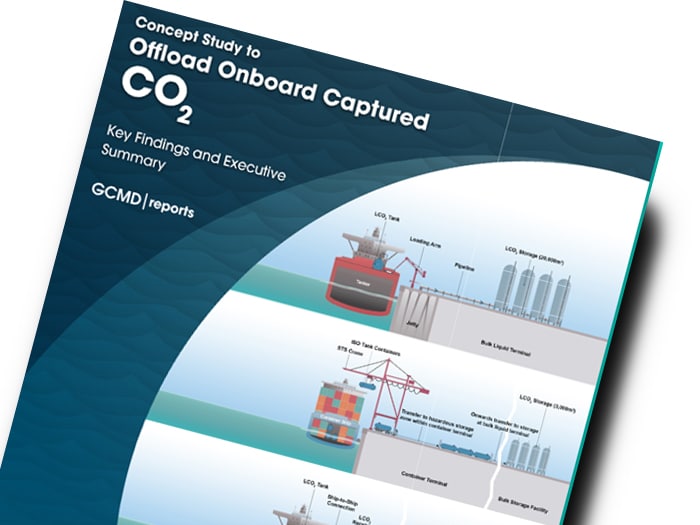
New GCMD study: Ports aren’t ready to handle onboard carbon capture
Written by Nick Blenkey
A study commissioned by the Singapore-based Global Center for Maritime Decarbonization (GCMD) finds that a lack of port readiness may present a carbon capture bottleneck. It comes as on board carbon capture and storage (OCCS) systems have been getting a lot of shipowner attention lately, with one just-announced pilot program targeting a capture rate of 70% of the carbon dioxide (CO2) in the exhaust gas from the main engine of an ethylene carrier.
Commissioned by GCMD in collaboration with Lloyd’s Register and London-based consultancy ARUP, the study has identified low port readiness as a major hurdle bottlenecking the adoption of OCCSs a practicable decarbonization solution. Whilst the technologies required for offloading onboard captured CO2 exist at high levels of maturity, safe operationalization of captured CO2 transfer by trained personnel has not been demonstrated.
“While pilots have successfully demonstrated numerous capture technologies onboard ships, it is still uncertain how captured carbon on merchant ships can be safely offloaded, and what the rest of the value chain looks like,” said GCMD CEO Professor Lynn Loo. “This study sheds light on these challenges, and highlights recommendations to holistically address these concerns for parties interested in advancing OCCS / LCO2 offloading concepts.”
The GCMD report, titled “Concept study to offload onboard captured CO2,” found that, while a limited number of ports possess the infrastructure to offload liquefied CO2 (LCO2), they are primarily designed to handle food-grade CO2. The higher purity standards that accompany this use limit the interoperability of facilities to handle onboard captured CO2.
The study examined over ten planned LCO2 related infrastructure projects worldwide. Located near, or with transport links from, CO2-emitting industrial clusters, these projects are likely to handle much larger volumes of captured CO2 than that from OCCS systems; port infrastructure needed for offloading, storing and transporting onboard captured CO2 will likely need to be integrated with these projects for economies of scale. However, as many of such projects remain in concept phase and have not reached Final Investment Decision (FID), ports have not proceeded with offloading infrastructure investments. This chicken-and-egg dilemma highlights the overall infancy of the carbon value chain.
Furthermore, the study finds that introducing LCO2 offloading into already complex port operations will likely impact port efficiency and operational performance. The need for additional buffer zones to address the safety concerns of LCO2 handling and storage will also add to existing space constraints at ports and terminals.
By systematically considering the needs of the entire value chain, the study evaluated four concept configurations of offloading infrastructure from a possible 162 scenarios, identified the operational standards and safety guidelines for handling LCO2, developed models for the quantification of costs for scaled-up infrastructure, articulated manpower competency frameworks for offloading operations, and analyzed the potential regulatory scenarios needed to address the current uncertainties surrounding LCO2 offloading from OCCS.
The study determined that captured CO2 in its liquefied form is likely the most efficient and cost-effective option for onboard storage and transport. Based on this, the study shortlisted four concepts covering key offloading modalities, such as Ship-to-Ship and Ship-to-Shore, serving as building blocks that can be combined to cover a wider range of offloading concepts.
In ranking the operability of these concepts, the study identified Ship-to-Ship and Ship-to-Shore transfers using an intermediate LCO2 receiving vessel as the most promising modalities for offloading at scale, with captured CO2 eventually sequestered or used as feedstock for manufacturing synthetic fuels.
Ship-to-Terminal transfer of captured CO2 stored in ISO tank containers was identified to be more compatible at smaller scales and for end uses that require higher grades of CO2. This means of transfer is also the most compatible with existing port infrastructure and therefore easier to pilot today.
Handling LCO2 onboard presents a unique set of safety challenges not commonly encountered when handling fuels in shipping. The study offers an in-depth examination of hazards, such as asphyxiation and toxicity, if a leak or a loss of containment takes place.
Unique to CO2 is evaluation of its storage at conditions near its “triple point,” where the gaseous, liquid and solid phases of CO2 co-exist. Storage at or near the triple point is sensitive to impurities, and minor changes in temperature and pressure can lead to a phase change from liquid to solid CO2, leading to hazardous situations, such as blockage in pipes and build-up of pressure.
Download the study HERE




